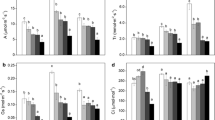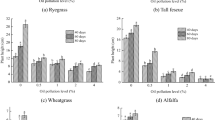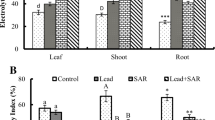Abstract
The petroleum production has been raised sharply over the past decades, whereas the petroleum exploitation has also caused serious environmental contamination. A pot experiment has been conducted to monitor the dynamic response of antioxidant defense system and the growth reaction of Amorpha fruticosa seedlings to soil petroleum contamination. The results show that (1) in 5 g kg−1 contaminated soil, A. fruticosa removes reactive oxygen species (ROS) by increasing the activities of antioxidant enzymes (glutathione reductase (GR), superoxide dismutase (SOD), catalase (CAT)), while in 10–15 g kg−1 long-term contaminated soil, A. fruticosa removes ROS by the cooperation of antioxidant enzymes and antioxidants (SOD, CAT, ascorbate peroxidase (APX), GR, ascorbic acid (AsA), glutathione (GSH), and proline (Pro)). In long-term 20 g kg−1 contaminated soil, the defense ability of APX and AsA decreases sharply, and A. fruticosa removes the ROS by the synergistic effect of antioxidant enzymes (SOD and CAT) and antioxidants (GSH and Pro). Only in 20 g kg−1 long-term petroleum contamination caused significant (P < 0.05) increase in H2O2 content in seedlings. (2) SOD, CAT, GR, GSH, and Pro exhibit increases in long-term severely contaminated soil, and these enzymes and antioxidants are the most important defender of A. fruticosa to ROS accumulation caused by petroleum contamination. (3) The growth of A. fruticosa seedlings is less affected in 5 g kg−1 petroleum-contaminated soil, while it significantly decreases in 10, 15, and 20 g kg−1 petroleum-contaminated soils (P < 0.05). (4) Considering comprehensively the response of antioxidant defense system and the growth reaction of seedlings to petroleum contamination, A. fruticosa could be utilized for phytoremediation in ≤15 g kg−1 contaminated soil.



Similar content being viewed by others
References
Achuba, F. I. (2014). Petroleum products in soil mediated oxidative stress in cowpea (Vigna unguiculata) and maize (Zea mays) seedlings. Open Journal of Soil Science, 4(12), 417.
Alkorta, I., & Garbisu, C. (2001). Phytoremediation of organic contaminants in soils. Bioresource Technology, 79(3), 273–276. doi:10.1016/S0960-8524(01)00016-5.
Andrade, M. L., Covelo, E. F., Vega, F. A., & Marcet, P. (2004). Effect of the Prestige oil spill on salt marsh soils on the Coast of Galicia (Northwestern Spain). Journal of Environmental Quality, 33(6), 2103–2110.
Asada, K. (1999). The water-water cycle in chloroplasts: scavenging of active oxygens and dissipation of excess photons. Annual Review of Plant Biology, 50(1), 601–639.
Bento, R. A., Saggin-Júnior, O. J., Pitard, R. M., Straliotto, R., da Silva, E. M. R., Tavares, S. R. D. L., et al. (2012). Selection of leguminous trees associated with symbiont microorganisms for phytoremediation of petroleum-contaminated soil. Water, Air, & Soil Pollution, 223(9), 5659–5671. doi:10.1007/s11270-012-1305-3.
Beyer, W. F., & Fridovich, I. (1987). Assaying for superoxide dismutase activity: some large consequences of minor changes in conditions. Analytical Biochemistry, 161(2), 559–566.
Bradford, M. M. (1976). A rapid and sensitive method for the quantitation of microgram quantities of protein utilizing the principle of protein-dye binding. Analytical Biochemistry, 72(1), 248–254.
Bramley-Alves, J., Wasley, J., King, C. K., Powell, S., & Robinson, S. A. (2014). Phytoremediation of hydrocarbon contaminants in subantarctic soils: an effective management option. Journal of Environment Management, 142, 60–69. doi:10.1016/j.jenvman.2014.04.019.
Brandt, R., Merkl, N., Schultze-Kraft, R., Infante, C., & Broll, G. (2006). Potential of vetiver (Vetiveria zizanioides (L.) Nash) for phytoremediation of petroleum hydrocarbon-contaminated soils in Venezuela. International Journal of Phytoremediation, 8(4), 273–284. doi:10.1080/15226510600992808.
Corseuil, H. X., & Moreno, F. N. (2001). Phytoremediation potential of willow trees for aquifers contaminated with ethanol-blended gasoline. Water Research, 35(12), 3013–3017.
del C Rivera-Cruz, M., Trujillo-Narcía, A., Ferrera-Cerrato, R., Rodríguez-Vázquez, R., Volke-Haller, V., Sánchez-García, P., et al. (2006). Fitorremediación de suelos con Benzo (a) Pireno mediante microorganismos autóctonos y pasto alemán [Echinochloa polystachya (HBK) Hitchc.]. Universidad y Ciencia, 22(1), 1–12.
Ding, H., Zhu, W., Yang, S., & Yang, X. (2005). Dynamic changes in antioxidative systems in roots of tomato (Lycopersicom esculentum Mill.) seeding under zinc stress and recovery. Chinese Journal of Applied & Environmental Biology, 11(5), 531–535.
Ellman, G. L. (1959). Tissue sulfhydryl groups. Archives of Biochemistry and Biophysics, 82(1), 70–77.
Euliss, K., Ho, C. H., Schwab, A. P., Rock, S., & Banks, A. K. (2008). Greenhouse and field assessment of phytoremediation for petroleum contaminants in a riparian zone. Bioresource Technology, 99(6), 1961–1971. doi:10.1016/j.biortech.2007.03.055.
Gong, X., Rong, L., Yang, L., Liu, Z., & Fang, Y. (2011). Effect and eco-toxicity of maize growth in petroleum contaminated soil. Environmental Science and Technology, 34(10), 71–75.
Han, G., Dang, Q., & Zhao, Z. (2008). Response of antioxidation protection system of Hedysarum scoparium to drought stress. Acta Botanica Boreali-Occidentalia Sinica, 28(5), 1007–1013.
Hernandez-Ortega, H. A., Alarcon, A., Ferrera-Cerrato, R., Zavaleta-Mancera, H. A., Lopez-Delgado, H. A., & Mendoza-Lopez, M. R. (2012). Arbuscular mycorrhizal fungi on growth, nutrient status, and total antioxidant activity of Melilotus albus during phytoremediation of a diesel-contaminated substrate. Journal of Environment Management, 95(Suppl), S319–324. doi:10.1016/j.jenvman.2011.02.015.
Karamalidis, A., Evangelou, A., Karabika, E., Koukkou, A., Drainas, C., & Voudrias, E. (2010). Laboratory scale bioremediation of petroleum-contaminated soil by indigenous microorganisms and added Pseudomonasaeruginosa strain Spet. Bioresource Technology, 101(16), 6545–6552.
Kechavarzi, C., Pettersson, K., Leeds-Harrison, P., Ritchie, L., & Ledin, S. (2007). Root establishment of Perennial ryegrass (L. perenne) in diesel contaminated subsurface soil layers. Environmental Pollution, 145(1), 68–74.
Kirk, J. L., Klirnomos, J. N., Lee, H., & Trevors, J. T. (2002). Phytotoxicity assay to assess plant species for phytoremediation of petroleum-contaminated soil. Bioremediation Journal, 6(1), 57–63.
Kirk, J. L., Klironomos, J. N., Lee, H., & Trevors, J. T. (2005). The effects of perennial ryegrass and alfalfa on microbial abundance and diversity in petroleum contaminated soil. Environmental Pollution, 133(3), 455–465. doi:10.1016/j.envpol.2004.06.002.
Li, F., Yao, J., & Wang, Q. (2006). Screening of plants for phytoremediation of petroleum-contaminated soils. Chinese Agricultural Science Bulletin, 22(9), 429–431.
Lin, Q., Mendelssohn, I. A., Suidan, M. T., Lee, K., & Venosa, A. D. (2002). The dose-response relationship between No. 2 fuel oil and the growth of the salt marsh grass. Spartina alterniflora. Marine Pollution Bulletin, 44(9), 897–902.
Liu, R., Xiao, N., Wei, S. H., Zhao, L. X., & An, J. (2014). Rhizosphere effects of PAH-contaminated soil phytoremediation using a special plant named Fire Phoenix. Science of the Total Environment, 473, 350–358. doi:10.1016/j.scitotenv.2013.12.027.
Moreira, I. T. A., Oliveira, O. M. C., Triguis, J. A., dos Santos, A. M. P., Queiroz, A. F. S., Martins, C. M. S., et al. (2011). Phytoremediation using Rizophora mangle L. in mangrove sediments contaminated by persistent total petroleum hydrocarbons (TPH’s). Microchemical Journal, 99(2), 376–382. doi:10.1016/j.microc.2011.06.011.
Moubasher, H. A., Hegazy, A. K., Mohamed, N. H., Moustafa, Y. M., Kabiel, H. F., & Hamad, A. A. (2015). Phytoremediation of soils polluted with crude petroleum oil using Bassia scoparia and its associated rhizosphere microorganisms. International Biodeterioration & Biodegradation, 98, 113–120. doi:10.1016/j.ibiod.2014.11.019.
Mukherjes, S., & Choudhuri, M. (1983). Implication of water stress induced change in the lever of endogenous ascorbic acid under hydrogen peroxide in vigna seedings. Physiology. Plant, 58(2), 166–170.
Ogboghodo, I., Iruaga, E., Osemwota, I., & Chokor, J. (2004). An assessment of the effects of crude oil pollution on soil properties, germination and growth of maize (Zea mays) using two crude types–Forcados light and Escravos light. Environmental Monitoring and Assessment, 96(1-3), 143–152.
Peng, S., Zhou, Q., Cai, Z., & Zhang, Z. (2009). Phytoremediation of petroleum contaminated soils by Mirabilis Jalapa L. in a greenhouse plot experiment. Journal of Hazardous Materials, 168(2-3), 1490–1496. doi:10.1016/j.jhazmat.2009.03.036.
Rahn, J. H. (2012). A test method for the evaluation of soil microbial health in a petroleum hydrocarbon contaminated boreal forest soil. Dissertation, The University of Guelph.
Ramos, D. T., Maranho, L. T., Godoi, A. F. L., da Silva Carvalho Filho, M. A., Lacerda, L. G., & de Vasconcelos, E. C. (2009). Petroleum hydrocarbons rhizodegradation by Sebastiania commersoniana (BAILL.) LB SM. & Downs. Water, Air, & Soil Pollution: Focus, 9(3-4), 293–302.
Ribeiro, H., Mucha, A. P., Almeida, C. M., & Bordalo, A. A. (2013). Bacterial community response to petroleum contamination and nutrient addition in sediments from a temperate salt marsh. Science of the Total Environment, 458–460, 568–576. doi:10.1016/j.scitotenv.2013.04.015.
Rong, L. (2010). Study on the effects of eco-toxicity of petroleum-contaminated soil on plants growth. Dissertation, Nanchang University.
Saruyama, H., & Tanida, M. (1995). Effect of chilling on activated oxygen-scavenging enzymes in low temperature-sensitive and-tolerant cultivars of rice (Oryza sativa L.). Plant Science, 109(2), 105–113.
Shukry, W., Al-Hawas, G., Al-Moaikal, R., & El-Bendary, M. (2013). Effect of petroleum crude oil on mineral nutrient elements, soil properties and bacterial biomass of the rhizosphere of jojoba. British Journal of Environment and Climate Change, 3(1), 103–118.
Soleimani, M., Afyuni, M., Hajabbasi, M. A., Nourbakhsh, F., Sabzalian, M. R., & Christensen, J. H. (2010). Phytoremediation of an aged petroleum contaminated soil using endophyte infected and non-infected grasses. Chemosphere, 81(9), 1084–1090. doi:10.1016/j.chemosphere.2010.09.034.
Spriggs, T., Banks, M. K., & Schwab, P. (2005). Phytoremediation of polycyclic aromatic hydrocarbons in manufactured gas plant–impacted soil. Journal of Environmental Quality, 34(5), 1755–1762.
Tanaka, K., Suda, Y., Kondo, N., & Nakano, Y. (1985). Ozone tolerance and the ascorbate-dependent hydrogen peroxide decomposing system in chloroplasts. Plant & Cell Physiology, 26(1425), 3.
Tang, J., Wang, M., Wang, F., Sun, Q., & Zhou, Q. (2011). Eco-toxicity of petroleum hydrocarbon contaminated soil. Journal of Environmental Sciences, 23(5), 845–851.
Tanida, M. (1996). Catalase activity of rice seed embryo and its relation to germination rate at a low temperature. Breeding Science, 46(1), 23–27.
Thavamani, P., Malik, S., Beer, M., Megharaj, M., & Naidu, R. (2012). Microbial activity and diversity in long-term mixed contaminated soils with respect to polyaromatic hydrocarbons and heavy metals. Journal of Environmental Management, 99, 10–17.
Wang, X., Feng, J., & Zhao, J. (2010). Effects of crude oil residuals on soil chemical properties in oil sites, Momoge Wetland, China. Environmental Monitoring and Assessment, 161(1-4), 271–280.
Wang, R., Wang, M., Niu, X., & Tang, C. (2015). Determination of total petroleum hydrocarbons content in soil by ultrasonic-soxhlet extraction-gravimetric analysis. Chinese Journal of Analytical Chemistry, 38(3), 417–420.
Xun, F., Xie, B., Liu, S., & Guo, C. (2015). Effect of plant growth-promoting bacteria (PGPR) and arbuscular mycorrhizal fungi (AMF) inoculation on oats in saline-alkali soil contaminated by petroleum to enhance phytoremediation. Environmental Science and Pollution Research, 22(1), 598–608.
Yang, C. (1987). Analysis technology for the petroleum contaminants in environment. Beijing: China Environmental Science Press.
Zhang, X. S., Kang, Y. J., & Xu, D. J. (2012). Physiological response of Lolium perenne to petroleum pollution and removal efficiency in petroleum-polluted soil. Advanced Materials Research, 518, 2665–2669. Trans Tech Publ.
Acknowledgments
The present research project is supported by “the Fundamental Research Funds for Northwest A&F University (QN2011162)” and “the National Forestry Industry Research Special Funds for Public Welfare Projects (201104002-4).”
Author information
Authors and Affiliations
Corresponding author
Rights and permissions
About this article
Cite this article
Cui, B., Zhang, X., Han, G. et al. Antioxidant Defense Response and Growth Reaction of Amorpha fruticosa Seedlings in Petroleum-Contaminated Soil. Water Air Soil Pollut 227, 121 (2016). https://doi.org/10.1007/s11270-016-2821-3
Received:
Accepted:
Published:
DOI: https://doi.org/10.1007/s11270-016-2821-3




